ALDO GIORGINI
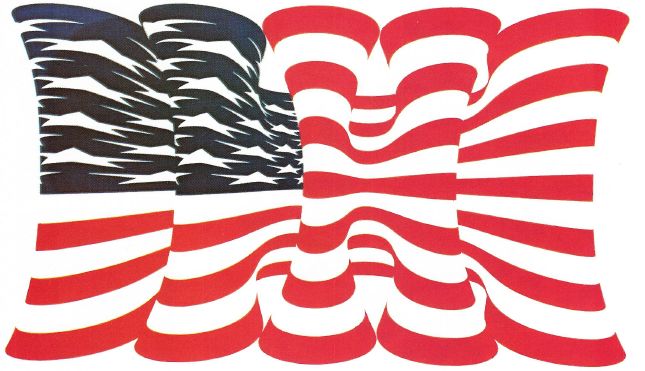
A Bicentennial Tribute, Aldo Giorgini. Copyright 1975 Aldo Giorgini
Dear Editor,
I hope you will accept my article in letter form. I think this device will allow me a freer hand than a normal article would, and, perhaps, a closer touch with the queries that you expressed in your call for papers.
My art background is, perhaps, somehow unusual if compared to the average American artist. At the age of ten, I was asked to apprentice to Carlo Ingeneri, a now well-known painter and sculptor of Decamere, Eritrea, who, to make a living, was teaching freehand drawing in the school I was attending. Initially my parents paid a fee which was later waived when my work in the shop was worth the instruction I received from the artist. World War II over, in 1949 my family moved back to Italy, where the same circumstance repeated itself. The freehand drawing instructor of the Scientific Lyceum I frequented in Voghera asked me to be his apprentice. Ambrogio Casati (this is his name) is a painter and sculptor who has worked in a number of media and has produced outstanding works which are now in high demand. He had been one of the handful of futurists that survived the ideologic condemnation of fascism and developed in a strong personal style that recalls both the Impressionists (for the subtle use of light) and the Futurists (for the special atmosphere of in fieri of his paintings).
Notwithstanding my dedication (I was spending an average of three hours a day in the studio) and my success in handling the media, I never considered seriously a future in art. The environment of my formative years (a mixture of maternal and paternal influence) had conditioned my order of achievement values roughly in the following order: Saint → Artist → Scientist → Hero → Builder → Politician and/or Moneymaker. A realistic assessment of my talents and the crushing conditioning of the above hierarchy made me choose engineering for a career.
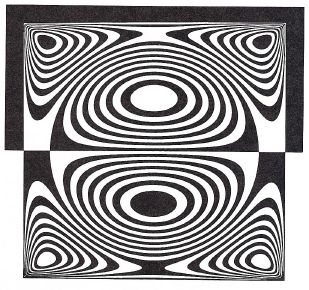
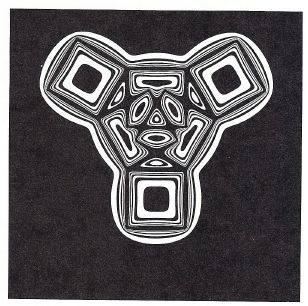
Since entering college I have only occasionally produced some artwork, but the dormant interest woke up four years ago, when I started developing a wet technique with enamels and acrylics that took literally two years to control. I call this process chastique (from stochastic technique).* The works done in this technique feature fantastic organic-like forms which, according to the words of Mario Contini, art critic of Eco D'Arte, Florence, Italy, are "characteristically well balanced, refined, and stimulating at the visual-interpretative level. Urging... masses full of meanings stand out from the background and arise as introductory archetypal data and as emblematic images, either for a free fantastical enjoyment or for an exclusively aesthetical fruition, ad libitum." I still work with this technique now and then, since I think that it is rich with possibilities for visual experiences, albeit I spend most of my time free from professional activities in the direction of computer visualizations.
As it may be suspected, I started using the computer as a scientific tool. In the years 1966-67, while Postdoctoral Fellow at the National Center for Atmospheric Research I worked on numerical simulation of turbulence. The research was very demanding at the visualization level and, therefore, I started playing with the output facilities for the best graphical representation of the results of my research. I made some computer generated movies with the CRT-microfilm facility of NCAR and in the waiting time between one output and the next I made some sequences of didactical nature about Fourier Analysis. Once at Purdue, I had some graduate students in the same field, and I started 'playing around' with some of the computer drawings that were made as illustration of the research done. From here to the purposeful use of the computer as an art tool the pace was very short.
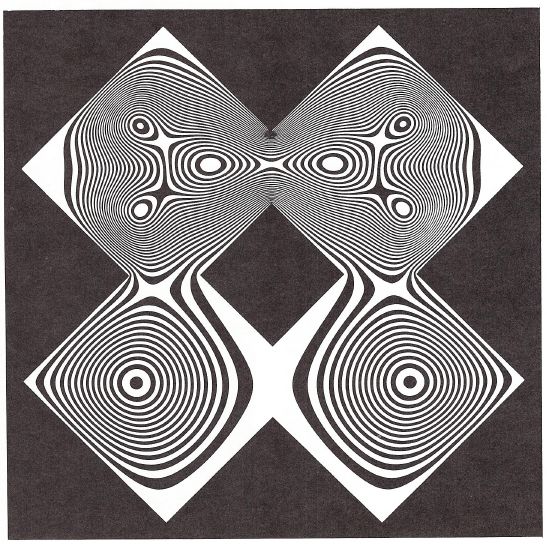
This being the origin of my computer efforts in art, it should not be surprising to discover that the way I use the computer in scientific endeavors has affected my thinking about its use for the production of art. In fluid-mechanic research by computer, the preparation of the computer programs and subroutines has always been seen by me as analogous to the design of laboratory facilities and of the instruments for physico-experimental research. I have called the complete set of programs and routines a 'numerical laboratory' for numerical 'experiments' in fluidmechanics. To be sure the time devoted to the design of the facilities and instruments (programs and subroutines) is of paramount importance, and sometimes one has to go beyond the conventional design for a true invention of instruments and facility parts. No matter how 'intoxicating' this design part, I've always tried never to lose track of the goal of the research: the experiments in fluidmechanics. The same attitude I have devoted to the 'computer visual experiments.' I have designed and invented programs and subroutines, not for their own sake but as components of the 'numerical laboratory' for the 'visual experiments.' You can see that this attitude is the same one that was implied in my mention of the chastique. In other words, in my view, programs and subroutines are the disposable part of the process of art by computer.
The prints that I send you have all been made using drawings generated with the program FIELDS, developed by myself with the help of Dr. W.C. Chen. These drawings (and some others not illustrated here) are the reason why the program was made. Other people may use this program, if they wish, (it has been published in its entirety with explanations for its use) but it must be realized that the 'numerical visual laboratory' called FIELDS, as any other program, is far less than a tool: it is literally a 'programme' with a large number of degrees of freedom for the user, but with a still larger number of degrees of freedom 'frozen in' by the designer. The user must realize that whatever output that program yields, it will reflect more the creative constraints of the designer of the program than those of the user. The user has to bend, to comply with a very general view of visual phenomena, and is bound to produce at best an original on the 'style' of the program, at worst a variation → imitation of one of the existing outputs.
The word style has been used here with intentional critical connotations: the use of one program will guarantee the development of a 'style' (which some critics may discover as broader than the slogan-type styles which some traditional artists develop with the only non-ostensible purpose of being singled out from the crowd). In my view, this is a cheap way of getting somewhere with a minimum of effort. It is true that the development of a numerical laboratory for visual experiments is justified by the diversity of experiments that can be performed (in other words: let one day of creation be followed by six days of restful, complacent contemplation). But, in my view, these experiments should explore the region delimited by the degrees of freedom of the program, and not describe in detail the minutest variations that lead from one 'original' to the next. If one proceeds in the latter direction, a lifetime of stylistically coherent artistic production is guaranteed to follow the one day of creation.
With the above, dear Editor, I feel that I have implicitly answered several of the questions that you have asked. I will now answer explicitly some others.
"Do you have a final image in mind when your work begins?"
I think that this fundamental question should concern more the behaviorist than the art critic or the artist himself. But the question is asked over and over to any artist. He is, therefore, compelled in the direction
- of introspecting himself in order to discover his modus operand!;
- of reporting the eventual findings.
While the introspective phase may have its positive influence on the artist's conscious behavior, the explanatory phase may result in deleterious effects, since it may produce cliches that aim more at astounding than at reporting. (A propos, have you seen the recent television documentary by the title "Hello Dali"? Is his theatrical apparatus just a self-made gilded cage for the dead bird that a miraculous mechanism provides with predictable motion and deja vu melody?)
As an overly simplified model for the modus operandi of an artist I offer, semi-facetiously, the following continuum between the two extremes CeMO and MeMO.
CeMO (purely Cerebral Modus Operand!)—The artist cogitat, ergo est. Visual images are entirely manipulated ... pardon ... mentipulated by the artist's mind and the result of this process is transferred, by any convenient mechanism (the artist's hand, an apprentice, a construction firm, a computer ...), into vulgar material substance (Hello Plato!).
MeMO (Memoriless Modus Operandi)—The artist can react only to what he sees in front of his eyes, without any ability to mentipulate the visual images. The gestures that ensue (hopefully intentional) modify the subject of his visual stimuli.
I think that both conventional artists and computer artists may be found spanning the whole continuum, albeit (non-interactive) computer artists may find themselves closer to CeMO than to MeMO. In my particular case, when I am operating in the computer mode, I tend to fully prefabricate the images mentally and then to render them by computer. The complexity of some of my drawings (see Turbulent Communication) usually creates some doubts about this assertion, since they are very mediate elaborations on moire patterns. Nevertheless it may not be difficult to accept the fact that a relatively large number of experiments performed on the visual effects of moire patterns can give a rather intimate familiarity with the ingredients for their design.
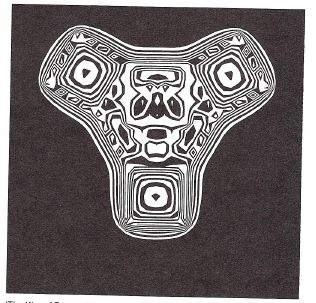
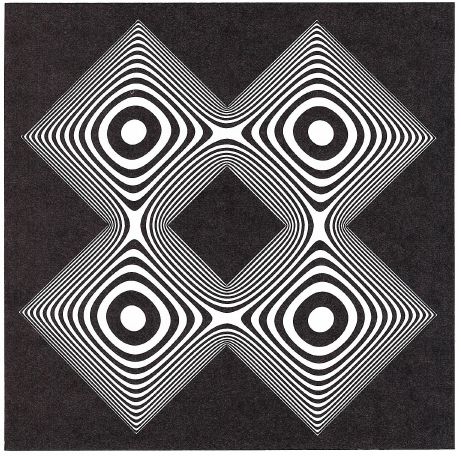
"Could your work be done without the aid of the computer?"
Yes, in a fashion analogous to the one of carving marble with a sponge. Since all FORTRAN instructions could be performed by other techniques, there is no doubt that one could execute the same by calculating and drawing by hand on a Cartesian plane. The difference between the two approaches lies merely in the amount of time required for the execution of the piece. The time constraint is of paramount importance in all endeavors and we are talking here of time ratios that approach some orders of magnitude. The question, nevertheless, is amenable to another interpretation which is more immediate in the following formulation: "Does your work with the computer affect the direction of your results?" This question is germane to the other: "Are your computer works related to your non-computer ones?"
I strongly believe that any one artist using two entirely different processes will achieve two sets of results that are entirely different at the purely visual level. The only liaison between the two sets of outputs is constituted by the aesthetico-formal handling of the visual material and, if at all present, by the motive substratum of the artist's activity ("what makes the artist do it").
Since the purpose of this collection of papers is to present some personal views about (computer) art, I will devote the remainder of this letter, dear Editor, to the exemplification of the above concepts with the particular case of my own works.
The motive substratum of my artistic activity is constituted by the fascination that natural forms have always exerted on me: from the extremely complex organic forms, rich of life-like attributes to the geometric forms of crystalline formations and to the forms of the invisible fields around us. My mental projection of the visual elements that 'describe' natural forms is constituted not by their 'substance,' their being objects, but by the surfaces that delimit such forms. In other words, I am not interested in recognizable individual objects, but in recognizable forms, be they organic, straight-line geometric, or free-flowing geometric.
From this it follows that the selection of the processes for the rendition of such forms will be conditioned by the forms themselves. Furthermore, the intrinsic capabilities of the process will only focus on the typology of forms amenable to description by the process.
I end my letter, dear Editor, with the mention of my first one-man show. The show was exhibiting computer and non-computer work. The computer work was featuring black and white geometric forms, the non-computer work exhibited multicolor organic-like forms. Obvious contrasts. But to me the remark "They look like the works of two different artists" sounded novel and amusing. The schizoidal element is only superficial (like the one between the artist and the scientist). The 'motor' is one, and so is its formal creative apparatus.
My best regards,
Aldo Giorgini
West Lafayette, Indiana
September 1975
FOOTNOTE
* Friends of mine suggest that the name would be more appropriate for an intimate hygiene spray for virgins.
Return to Table of Contents | Previous Section | Next Section

